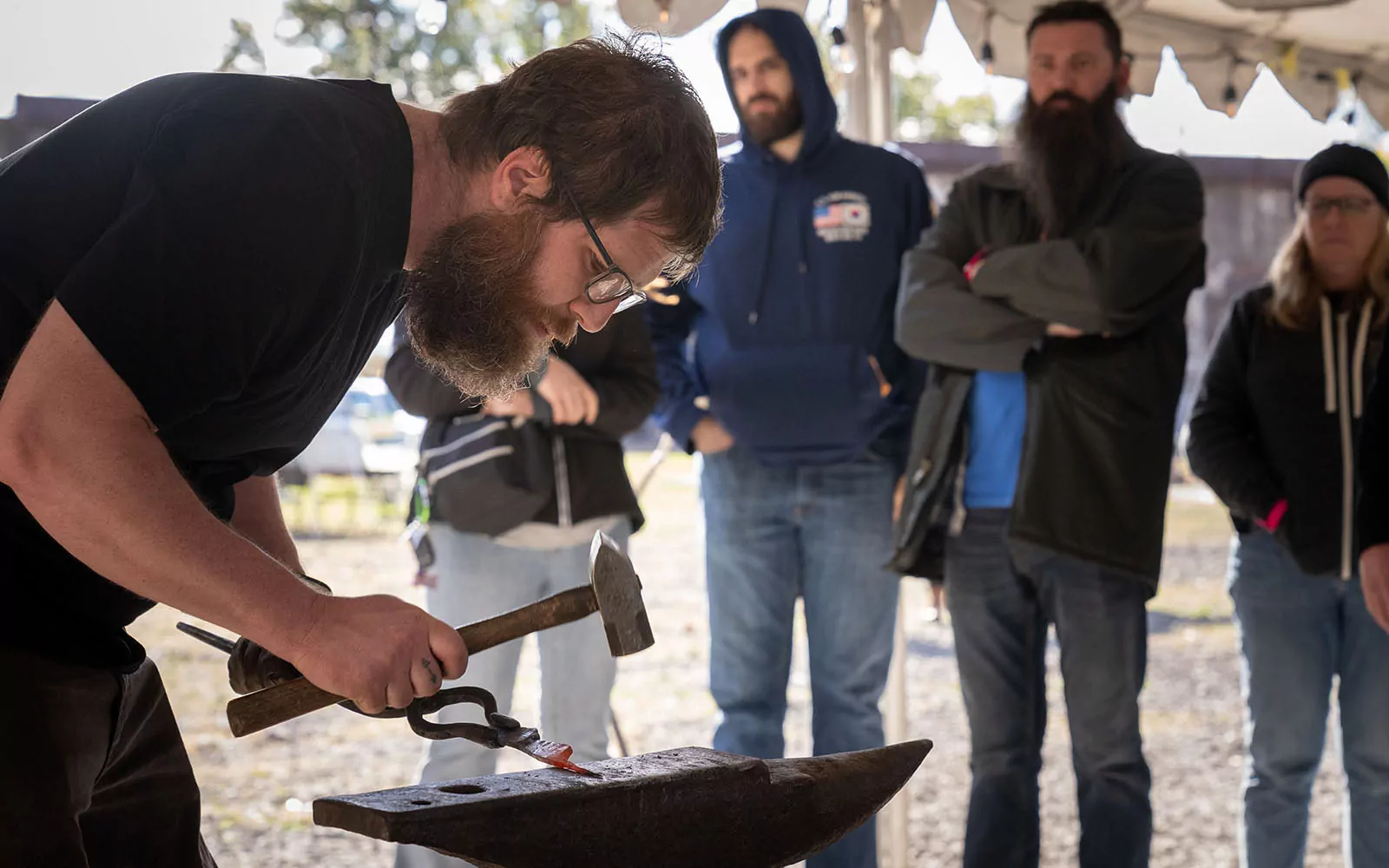
Jared Ondovchik at the 2022 Festival of Combustion at the Carrie Blast Furnaces.
Profiles in Steel
Rivers of Steel’s Profiles in Steel series shines a spotlight on the talented members of our organization’s community. From staff and volunteers to collaborators and patrons, it takes a dedicated group with many and varied talents to support the community-based initiatives offered through Rivers of Steel.
In this installment, we meet Jared Ondovchik, a local blacksmith who’s been partnering with Rivers of Steel for several years and has recently joined our metal arts team as a staff member.
Introducing Jared Ondovchik
By Carly V. McCoy
If you happen to get Jared Ondovchik talking about his work as a blacksmith, it doesn’t take him long to share that he’s self-taught. He’ll mention it in a self-effacing sort of way. Take the conversation a little bit further, and Jared will be sure to acknowledge some of the artists whose paths dovetailed with his own journey, opening his eyes to possibilities, creating opportunities, and offering suggestions in pursuit of this ancient craft.
A Craftsman’s Journey
Jared Ondovchik got his start working on one of Pittsburgh’s most iconic pieces of public art—The Workers sculpture, which resides on Pittsburgh’s South Side along the Three Rivers Heritage Trail. A piece created by the Industrial Arts Co-op, it is most closely associated with the work of sculptor and arts executive Tim Kaulen. However, the project incorporated twenty-four additional metal artists, including Jared.
For Jared, one of the most appealing elements of his experience participating on The Workers was the industrial scale of the artwork.
“I really liked how permanent and severe metalworking seemed,” said Jared Ondovchik about The Workers. “The other folks working on the project were awesome people and really open about helping me learn my way around the tools. Those first times that I blasted sparks everywhere from a grinder or welder were pretty addicting.”
But it was the Co-op artists’ do-it-yourself ethos that inspired him to make his first forge—crafted from a brake drum and pipes found within the abandoned warehouse in which they were working. Along with the coal to fuel it that was sourced from the ground underfoot, a nearby rail served as an anvil.
“There was also something to the space we were working in,” Jared continued. “I think it’s just condos now, but at the time, it was this abandoned coke mill. The wall facing the river had pretty much eroded away; there were huge holes in the roof so rain and snow would fall in. When I built my first forge I would go out and just pick coal up off the ground for fuel—it felt really special.”
It didn’t take him long to realize how much he enjoyed working with metal, and he applied this DIY approach to learning the craft, searching internet forums for materials, techniques, and the like.
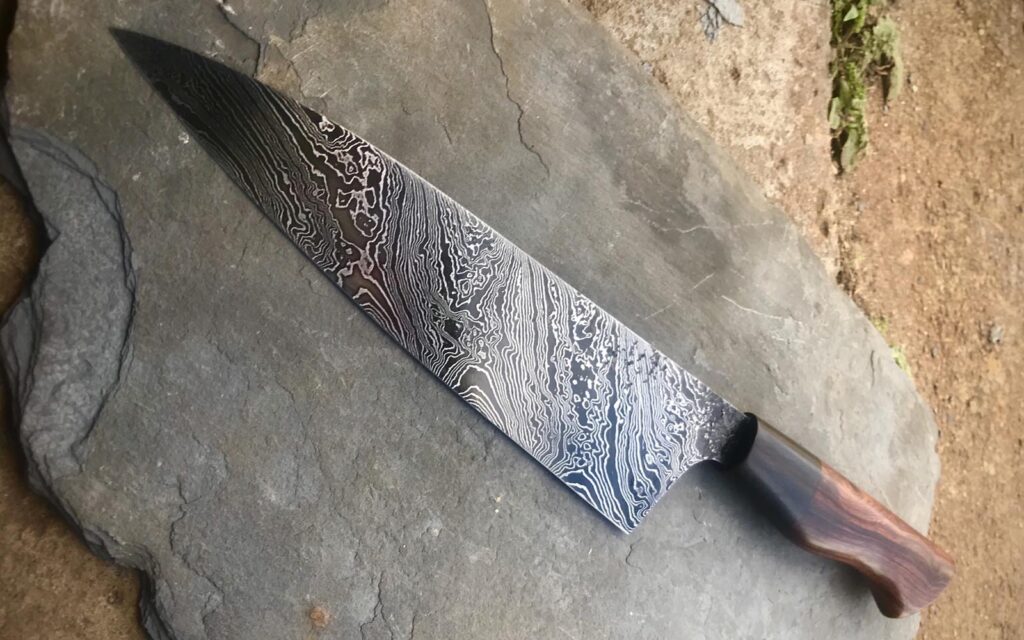
A Damascus chef’s knife forged by Jared Ondovchik, made with eighty-eight layers of two types of steel in a twist pattern, complemented by an ironwood handle with a blackwood ferrule. Image courtesy of the artist.
Bladesmithing
From the start, crafting knives was the real draw for Jared. You can hear the reverence in his voice when he speaks about creating these functional artworks. Whether it is a reference to the process of creating to a Damascus blade, a chef’s knife that is appreciated by an actual chef, or adding handles from local hardwoods, the love for the blacksmithing tradition is plainly evident.
“Weirdly—or maybe not weirdly at all?—what drew me to bladesmithing and what I still love about it are the same things that can drive me nuts about it,” Jared explained. “Knives have to be heat treated to hold an edge and, essentially, withstand abuse. When you harden and temper a piece of steel, you are changing how the metal relates to itself. That metallurgic aspect is kind of missing from forging or fabricating with plain steel.”
“I also love the legacy that tools and weapons have,” Jared continued. “It can be dark, but our history using those items for agriculture, war, or tooling have had massive impacts on human history. Along those historical lines, and on a more personal note, it was always really important to my dad that I had a pocket knife on me. My grandpa—my dad’s dad—died when I was eleven, and he left me a shotgun and a junior buffalo-skinning knife. I never got super into guns, but that knife is in my bedside table. I’ve carried it with me everywhere I’ve moved. It just always felt really special.”
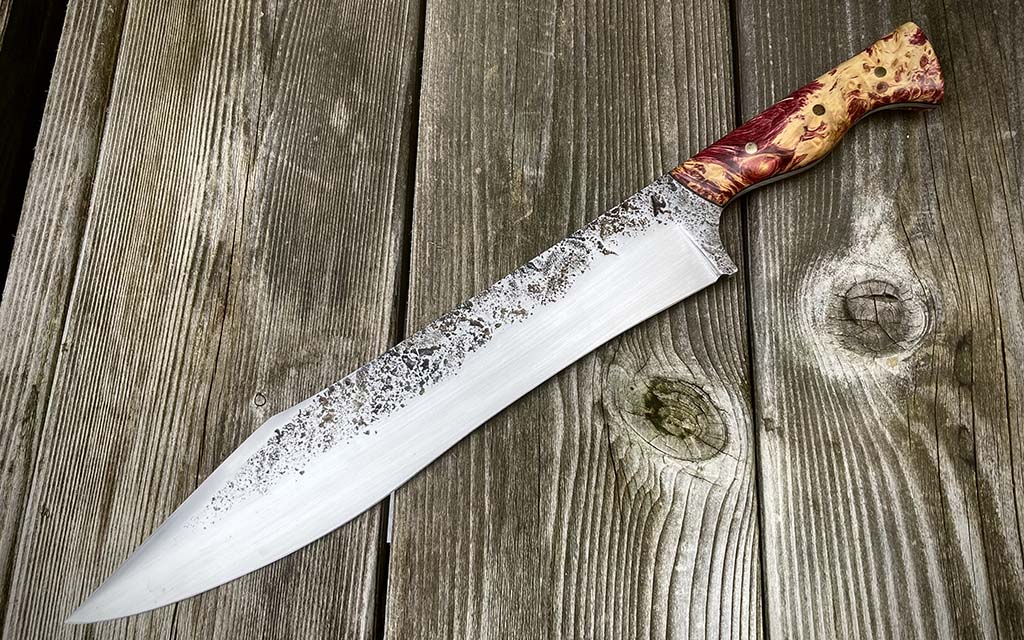
A camp chopper forged from 80CrV2 steel with dyed and stabilized cedar burl, crafted by Jared Ondovchik. Image courtesy of the artist.
In time, Jared Ondovchik began to show and sell his knives at makers’ markets around Pittsburgh, including the Polish Hill Arts Festival, Handmade Arcade, I Made It! Market, and the Neighborhood Flea. The local cottage industry around handmade / artisan-made goods provided a foundation for his own burgeoning business, and about five years into his practice Ondovchik was able to leave his other jobs (which had included bartending and construction work) to focus on his own newly incorporated business, Artifact Metalworks.
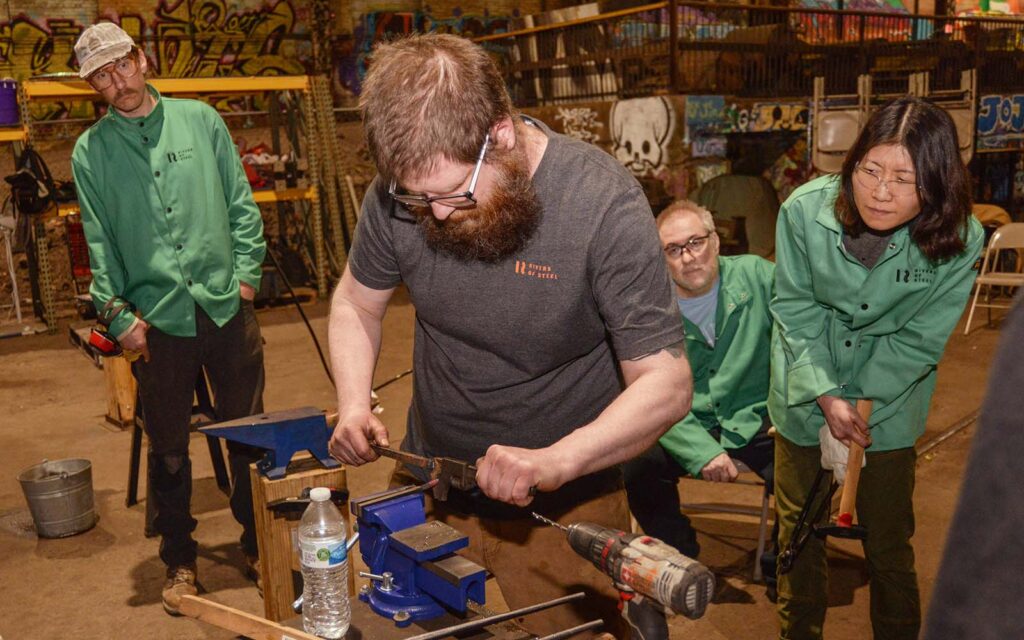
During the inaugural Blacksmithing Basics workshop, Jared demonstrates how to add a twist for students working on their hooks and hairpins.
Informal Mentorships
While the other makers provided a creative community for Jared and his practice, it was his experiences with his blacksmithing peers that helped him further his craft. Fellow artist Glen Gardner introduced him to Touchstone Center for Crafts, which is where he met other metalworkers, including Anna Koplik. From tips on how to heat treat his blades to more nuanced approaches on how to hold his hammer, Ondovchik improved his own practice while gaining skills as an educator and teaching assistant.
“I have had a few people who have taken some form of a mentor role,” Jared acknowledged. “Glen Gardner has probably had the biggest impact. He just knows everything about metalwork. He’s been doing it his entire adult life, and he’s just a wealth of knowledge. I didn’t have anyone to talk to when I first started, for probably the first four years or so—but when I was introduced to Glen, right away he offered to answer questions.
“I was having issues with my heat treats. I’d been reading on forums and trying to figure out what I was doing wrong, agonizing over it and heat treating test pieces to try and get the grain structure right—just hours of messing with this stuff. I called Glen and he just said, ‘Oh, you’re getting it too hot.’ And that was it—heat treats were fixed!
“Through Glen I met all the folks at Touchstone, which is where I met Anna Koplik, who really helped me realize how bad my form was from being self-taught. My arm hurt all the time, and I didn’t know why. Anna helped me figure that all out and shared a lot with me about tooling. Both Anna and Glen are incredibly detail oriented, and they don’t let shoddy work slide. They’ve both always been there to help me keep my standards very high.”
Jared also credits Ed Parrish, Rivers of Steel’s furnace master and metal arts coordinator, in helping to shape his view on metalwork overall.
“Ed Parish was huge in turning me onto some really influential blacksmithing work that helped me expand what I thought was possible with metal work. He’s always had this attitude that was kind of like, ‘You can make anything out of metal.’ That didn’t come naturally to me. Being self-taught, sometimes metalwork felt impossible. Ed’s taken a lot of time showing me what tooling and techniques to use to push the limits of what’s possible with blacksmithing.”
As he concluded this thought, Jared acknowledged with a soft laugh, “There are a few more people I could name, but that’s already a lot, it seems.”
Collaborating with Rivers of Steel
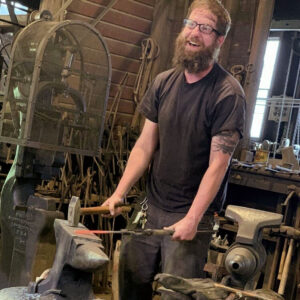
Jared practicing his craft on an anvil at the W.A. Young & Sons Foundry and Machine Shop.
It was around the time that Jared was connecting with his peers at Touchstone that he also began working in partnership with Rivers of Steel, having been introduced to our metal arts program by Ed Parrish. Showcasing his blacksmithing skills through public demonstrations, Jared participated in Rivers of Steel’s annual Festival of Combustion and at offsite events like Riverfest in Rices Landing and the 2018 Create Festival presented by the Pittsburgh Technology Council in partnership with the Three Rivers Arts Festival.
With the introduction of several blacksmithing workshops to Rivers of Steel Arts’ offerings this year, we’re happy to share that Jared Ondovchik has joined Rivers of Steel’s staff as a member of our metal arts team.
“We had been discussing the potential of offering blacksmithing classes here at Carrie for quite a while,” said Chris McGinnis, director of Rivers of Steel’s arts programs. “It always seemed like something got in the way and the process kept getting pushed back, but Jared was always the logical choice to be an instructor. He definitely has the type of local story and clear dedication to his craft that’s so important for our program. And it’s matched by an unpretentious confidence that really fits well with the culture we are trying to cultivate here.”
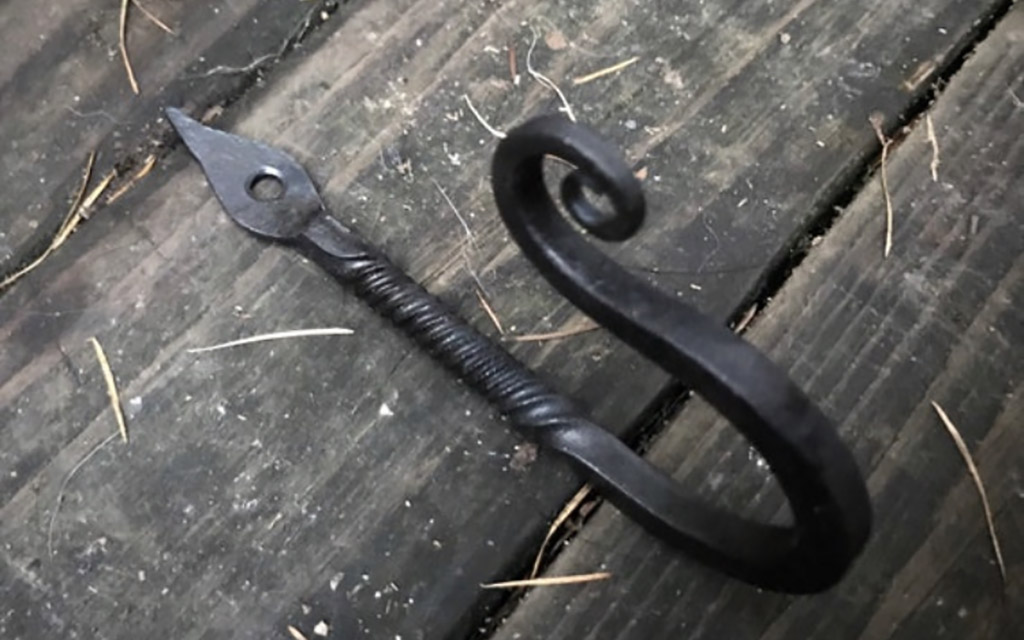
An example hook for the Blacksmithing Basics workshop.
The Blacksmithing Basics series of workshops provides an opportunity to anyone who can lift a hammer to create something to take home by the end of the three-hour workshop. Skills taught include hammer control, how to move the steel, scrollwork, and creating a forged finish. The Hooks & Hairpins session is offered multiple times this season, which creates opportunities for participants to simply have a fun evening while trying out a new skill, or to return more than once to continue practicing the craft. Later in 2023, special Blacksmithing Basics classes will feature holiday themes, from Halloween and autumnal objects to Christmas trees.
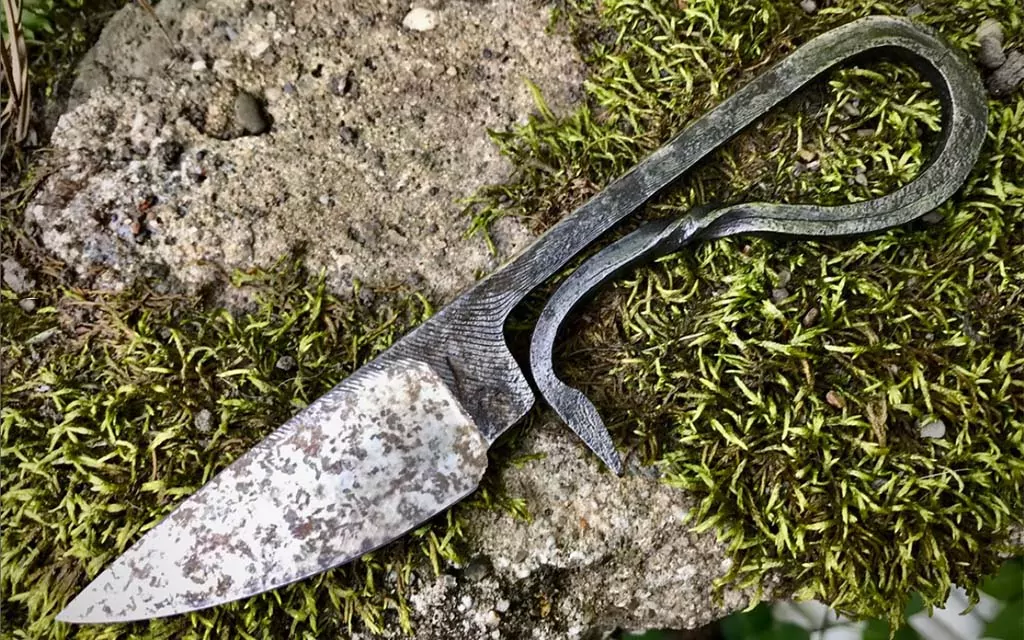
A scroll-handled knife with a mustard patina by Jared Ondovchik, similar to what will be made in the Bladesmithing workshop. Image courtesy of the artist.
A three-day Bladesmithing workshop will also be offered a few times this year, in May, July, and September. No experience is required for this workshop, either. At the end of the three days, everyone will leave with a finished, scroll-handled, Iron Age-style knife. This style is also known as a Viking knife or a blacksmith’s knife.
Jared’s next Blacksmithing Basics workshop is on April 20. You can sign up for the first Bladesmithing workshop offered May 8 – 10, 2023.
Interested in reading more Profiles in Steel? Check out the features on John Mahn, Jr. or on Ed Parrish, Jr.







